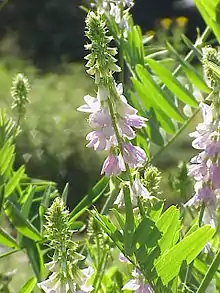Galactagogue
A galactagogue, or galactogogue (from Greek: γάλα [γαλακτ-], milk, + ἀγωγός, leading), is a substance that promotes lactation in humans and other animals.[1][2] It may be synthetic, plant-derived, or endogenous. They may be used to treat low milk supply.

Pharmaceutical
Synthetic galactagogues such as domperidone and metoclopramide interact with the dopamine system in such a way to increase the production of prolactin; specifically, by blocking the D2 receptor.[3] There is some evidence to suggest that mothers who are unable to meet their infants' breastfeeding needs may benefit from galactogogues.[4][5] Galactagogues may be considered when non-pharmacologic interventions are found to be insufficient.[6][7] For example, domperidone may be an option for mothers of preterm babies who at over 14 days from delivery and after full lactation support still have difficulty expressing breast milk in sufficient quantity for their child's needs.[8]
Domperidone (like metoclopramide, a D2 receptor antagonist) is not approved for enhanced lactation in the USA.[9][10] By contrast, Australian guidelines consider domperidone to be the preferred galactagogue when non-pharmacological approaches have proved insufficient.[6] Unlike metoclopramide, domperidone does not cross the blood-brain barrier and does not tend to have adverse effects such as drowsiness or depression.[6]
Other drugs which may increase lactation include:
- Antipsychotics such as risperidone, chlorpromazine and sulpiride, due to their ability to block the D2 receptor[11]
- Certain hormones such as oxytocin, growth hormone (GH), thyrotropin-releasing hormone (TRH), and thyroid-stimulating hormone (TSH)[11]
Herbal
Herbals and foods used as galactogogues have little or no scientific evidence of efficacy, and the identity and purity of herbals are concerns because of inadequate testing requirements.[12] The herbals most commonly cited as galactagogues are:[12]
- shatavari (Asparagus racemosus)[12]
- fenugreek (Trigonella foenumgraecum)[12][13]
- torbangun (Coleus amboinicus), which has been used by the Batak people of Indonesia as a galactogogue for hundreds of years.[12][14]
- fennel (Foeniculum vulgare)[12]
- milk thistle (Silybum marianum)[12] ; in 2010 the European Food Safety Authority considered and rejected a claim for silybum as a galactagogue because the evidence was deemed insufficient.
- chasteberry (Vitex agnus castus)[12]
- goat’s rue (Galega officinalis)[12]
Other herbals that have been claimed to be galactagogues include:
References
- Gabay, M. P. (2002). "Galactogogues: Medications that induce lactation". Journal of Human Lactation. 18 (3): 274–279. doi:10.1177/089033440201800311. PMID 12192964.
- Merriam-Webster: galactogogue
- Forinash AB, Yancey AM, Barnes KN, Myles TD (2012). "The use of galactogogues in the breastfeeding mother". Ann Pharmacother. 46 (10): 1392–404. doi:10.1345/aph.1R167. PMID 23012383.
- McInnes RJ, Chambers J (2008). "Infants admitted to neonatal units—interventions to improve breastfeeding outcomes: a systematic review 1990-2007". Matern Child Nutr. 4 (4): 235–63. doi:10.1111/j.1740-8709.2008.00150.x. PMC 6860595. PMID 18811790.
- Osadchy A, Moretti ME, Koren G (2012). "Effect of domperidone on insufficient lactation in puerperal women: a systematic review and meta-analysis of randomized controlled trials". Obstet Gynecol Int. 2012: 642893. doi:10.1155/2012/642893. PMC 3306907. PMID 22461793.
- Amir LH, Pirotta MV, Raval M (2011). "Breastfeeding—evidence based guidelines for the use of medicines". Aust Fam Physician. 40 (9): 684–90. PMID 21894275.
- Forinash AB, Yancey AM, Barnes KN, Myles TD (October 2012). "The use of galactogogues in the breastfeeding mother". Ann Pharmacother. 46 (10): 1392–404. doi:10.1345/aph.1R167. PMID 23012383.
- Donovan TJ, Buchanan K (2012). "Medications for increasing milk supply in mothers expressing breastmilk for their preterm hospitalised infants". Cochrane Database Syst Rev. 3: CD005544. doi:10.1002/14651858.CD005544.pub2. PMID 22419310.
- Da Silva, O. P.; Knoppert, D. C. (2004). "Domperidone for lactating women". Canadian Medical Association Journal. 171 (7): 725–726. doi:10.1503/cmaj.1041054. PMC 517853. PMID 15451832.
- The Academy Of Breastfeeding Medici (2011). "ABM Clinical Protocol #9: Use of Galactogogues in Initiating or Augmenting the Rate of Maternal Milk Secretion (First Revision January 2011)". Breastfeeding Medicine. 6 (1): 41–49. doi:10.1089/bfm.2011.9998. PMID 21332371.
- Zuppa, Antonio; Paola Sindico; Claudia Orchi; Chiara Carducci; Valentina Cardiello; Costantino Romagnoli; Piero Catenazzi (2010). "Safety and Efficacy of Galactogogues: Substances that Induce, Maintain and Increase Breast Milk Production". Journal of Pharmacy & Pharmaceutical Sciences. 13 (2): 162–174. doi:10.18433/j3ds3r.
- Mortel M, Mehta SD (May 2013). "Systematic review of the efficacy of herbal galactogogues". J Hum Lact. 29 (2): 154–62. doi:10.1177/0890334413477243. PMID 23468043.
- Chantry, Caroline J.; Howard, Cynthia R; Montgomery, Anne; Wight, Nancy (2004). "Use of galactogogues in initiating or augmenting maternal milk supply" (PDF). ABM protocols, Protocol#9. The Academy Of Breastfeeding Medicine. Archived from the original (PDF) on 28 June 2007.
Supported in part by a grant from the Maternal and Child Health Bureau, Department of Health and Human Services.
Cite journal requires|journal=(help) - Damanik R, Wahlqvist ML, Wattanapenpaiboon N (2006). "Lactagogue effects of Torbangun, a Bataknese traditional cuisine". Asia Pac J Clin Nutr. 15 (2): 267–74. PMID 16672214.
- http://canadianbreastfeedingfoundation.org/induced/herbs.shtml
- Nice, F. J. (19 May 2011). "Common Herbs and Foods Used as Galactogogues". ICAN: Infant, Child, & Adolescent Nutrition. 3 (3): 129–132. doi:10.1177/1941406411406118.
- https://www.drugs.com/breastfeeding/moringa.html
External links
| Look up galactagogue in Wiktionary, the free dictionary. |
| Look up galactogogue in Wiktionary, the free dictionary. |